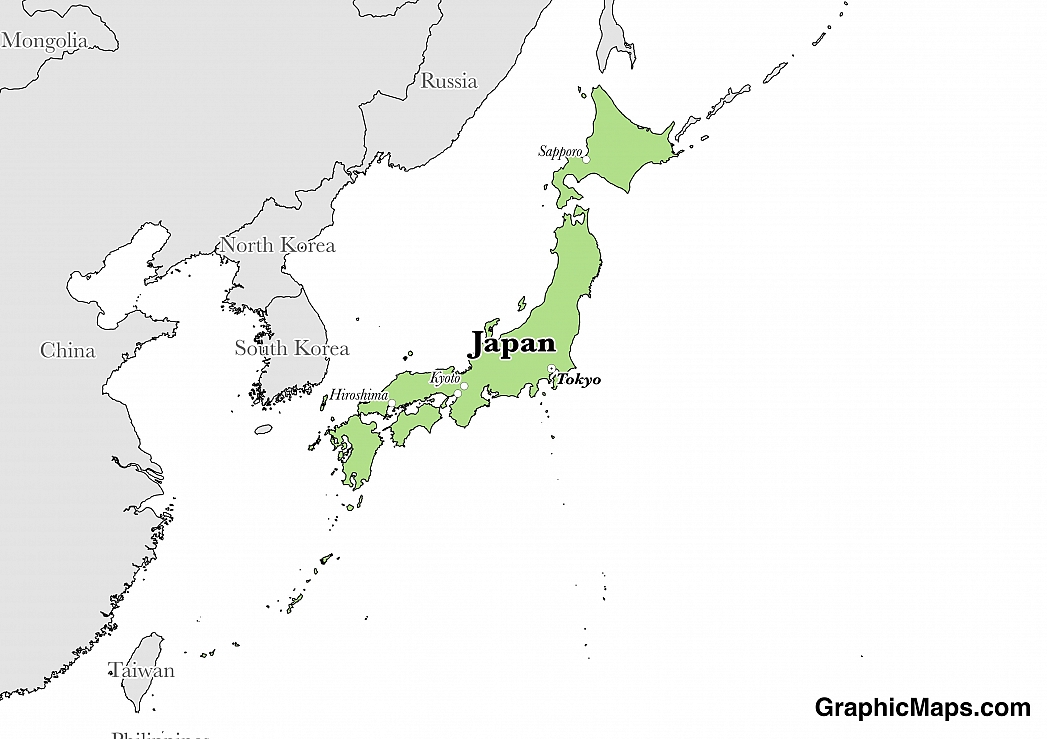Where is Japan?
Located in Eastern Asia, Japan is an island nation. It has a 29,751.00 km coastline. Sovereignty disputes exist between Japan and Russia over what Japan calls the "northern territories".
Tokyo is located in the Kanto region of Japan on the southeastern part of Honshu Island which is the main island of the country. Tokyo also encompasses the Izu and Ogasawara Islands. And modern Tokyo remains the official home of the Emperor of Japan as well as the Japanese parliament. Tokyo was formerly known as Edo, has been the defacto location of Japanese government since 1603. The city was renamed Tokyo and given status as the capital city in 1868. The climate of Japan can be classified as a humid subtropical climate, characterised by a warm and humid summer as well as a cool winter with sporadic cold weather that sees annual snowfall in Tokyo City. Tokyo is a very desirable destination for tourists, and the city ranks highly regarding the diversity of its attractions.
Read more on Japan's CapitalJapan is an Asian country covering 377,915.00 km2 of which 3.55% is water and 364,485.00 km2 is land. The area includes Bonin Islands (Ogasawara-gunto), Daito-shoto, Minami-jima, Okino-tori-shima, Ryukyu Islands (Nansei-shoto), and Volcano Islands (Kazan-retto). This makes it the 61st largest country in the world and slightly smaller than California. Its geographic coordinates are 36 00 N, 138 00 E and Tokyo is the capital city.
The English word for Japan comes from the Chinese name for the country, "Cipangu".
Its ISO code is JP.
Geography
Japan has a mean elevation of 438 m above sea level.
Its climate varies from tropical in the south to cool and temperate in the north. Its terrain is mostly rugged and mountainous.
Population
Japan has a population of 126,702,133 making it the 10th largest in the world. One-third of the population lives in and around Tokyo.
Japanese is the official language. The majority ethnic group is Japanese. The majority of the population practices Shintoism.
The official language of Japan is Japanese, specifically the Tokyo dialect which is considered the standard version of the language. An overwhelming 99 percent of the country speaks Japanese as their first language. There are approximately 127 million Japanese speakers worldwide (primarily from Japan) which makes it the ninth most spoken language in the world. The origins of the language have been a hotly debated issue within academia for many years, but the most widely held belief is that Japanese originated from the Ural-Altaic family of languages which includes Korean, Mongolian, and Turkish. The language is made up of two sets of syllable characters (50 syllables in each) as well as around 2,000 Kanji characters which make it a tough language to read and write for beginners.
Read more on Japan's LanguagesThe dialing code for the country is 81.
Government
Japan is an independent country. Its current constitution was adopted in 1947. Its constitution was last ratified in 1947.
Japan's system of government can be described as a constitutional monarchy in which the monarch is relegated to ceremonial and national festivities. The 1947 Constitution of Japan gives the Emperor the official head of state title, but it also gives executive power to the cabinet which is composed of the Prime Minister and Ministers of State. The National Diet is Japan's house of parliament, and it is located in downtown Tokyo near the Imperial Palace. This house of parliament contains 475 members, 295 of these members are from single-seat constituencies, and the remaining 180 members are from proportional representation from 11 districts. Elections are held every three years in Japan and the voting age is 18.
Read more on Japan's GovernmentEconomy
Factoring in Purchasing Power Parity, Japan's GDP is $4,930,000,000,000.00 (USD) with $38,900.00 (USD) per capita. This makes it the 4th largest economy and its citizens the 42nd richest in the world. The currency of Japan is the Yen (JPY).
Its major export partners are the United States, China, and South Korea. Its main exports are motor vehicles, iron and steel products, and semiconductors. Its major import partners are China, the United States, and Australia. Its major imports include petroleum, liquid natural gas, and clothing.
Flag
The flag of Japan consists of a white rectangular field, centred by a crimson-red disc. The modern flag of Japan is known as the Nisshoki, or “sun-mark flag”, as well as the Hinomaru, or the “circle of the sun”. There are historical accounts of the flag being used as early as 701 AD as well as a written reference to Japanese national banners that had a similar sun-like pattern in the centre in the 8th, 9th, 10th, and 11th centuries. Additionally, artists renderings of Japanese ships in the late 16th Century fly a very similar flag to the Hinomaru. The Act on National Flag and Anthem was ratified on 13 August 1999, and before this law was enabled, Japan had no official flag or national anthem.
Read more on Japan's FlagThis page was last modified on January 17th, 2018
More on Graphicmaps

Published on 2019-11-06
What is a Trade Embargo?

Published on 2019-11-04
Which Two Countries Used to Have the Same Flag?

Published on 2019-09-16
What Is the Only Two-Sided State Flag?

Published on 2019-09-16
Which Country Flag Looks Like the Texas Flag?

Published on 2019-08-29
Flags That Resemble the US Flag

Published on 2019-08-20
